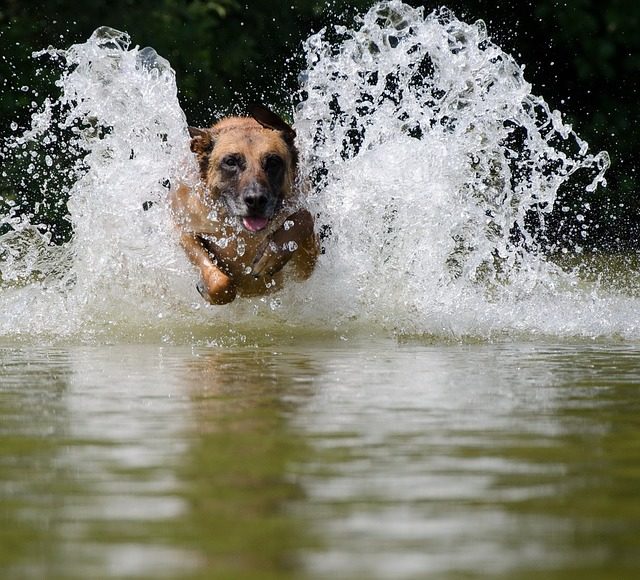
Sadly, each summer there are reports of dogs dying of toxic algae poisoning in several states across the nation. These stories terrify dog owners.
Initially, in each of the situations reported, they are out for a day of fun when their dogs began to show signs of poisoning. Later, the symptoms progressed so fast that there was little that could be done. Unfortunately, their day of joy quickly became one of sorrow.
Consequently, heartbreaking stories of dogs dying within hours of swimming in water containing toxic algae are reported each year. These deaths have occurred in several states.
For example, Georgia resident, Morgan Fleming, used Facebook this past summer to warn other dog owners of the potential risk. This risk is greatest in warm weather.
Dogs Dying of Toxic Algae Poisoning
Morgan and her husband took Arya, their border collie, for a swim in a nearby pond. This was a favorite way for them to beat the summer heat.
Unfortunately, it never crossed their minds that dogs die of toxic algae poisoning. They certainly never considered Arya to be at risk of death from a frolic in the pond.
Fleming wrote in a post, that subsequently went viral, the following comments: “About 30 minutes later on the drive home, we noticed her making weird noises and she threw up and pooped in the car,” (Be Warned: some may find photos disturbing).
“We called our vet on the drive and they suggested we take her in. By this point, our girl couldn’t even stand… They told us she was in critical conditions so we took her to the ER.
By the time we got there, she was brain dead… Today was absolutely awful. We lost our fun, loving, and crazy girl to what we can only assume was a lake toxin such as blue-green algae.”
Posted by Morgan Fleming on Saturday, August 10, 2019
Photo above was shared by Morgan Fleming on her Facebook post. She is seen here enjoying the afternoon with Arya.
More Dogs Dying of Toxic Algae Poisoning
Two North Carolina women took their three dogs, a Golden Doodle mix, and two West Highland Terriers on an outing. They took them to play in the mud and swim in a local pond.
One of the dogs began having a seizure within minutes of leaving the pond, reported owner Melissa Martin on Facebook. According to Martin, all three dogs were dead by the end of the night, three more innocent victims of Blue-Green Algae poisoning.
“At 12:08 AM, our dogs crossed the rainbow bridge together,” Martin wrote. “They contracted blue-green algae poisoning and there was nothing they could do. We are gutted. I wish I could do today over.”
You can read their entire story here: Owner On A Mission After 3 Dogs Killed By Toxic Algae.
The photo above is of Harpo, Abbie, and Izzie. Martin is on a mission to see that their deaths will not have been in vain. They intend to put signs at every body of water that can have these deadly bacteria and have established a GoFundMe account to finance this mission.
If you’d like to be part of their initiative: https://www.facebook.com/1371655799/posts/10219956373964324?s=1371655799&sfns=mo
Dogs Died of Toxic Algae Poisoning Before This Latest Set of Events 
Woods Creek Lake in Lake In The Hills was closed for nearly a week after toxic algae were discovered there earlier this summer. The St. Charles Park District warned dog owners two years ago to keep out of the water when toxic algae were found in a pond at a dog park.
Several dogs have also reportedly died after swimming in an Austin, Texas lake. This lake is also believed to be contaminated with toxic blue-green algae, or Cyanobacteria.
So, Just What Is Cyanobacteria and Where Is It Found?
More commonly called Blue-Green Algae, it is a microscopic bacteria usually found in freshwater ponds, streams, lakes, and brackish water. Not all types of algae are poisonous.
However, some are so dangerous that it is imperative that you prevent your pet (or child) from being exposed to it. Do not allow them to swim in, or drink from, water with any chance of being contaminated with blue-green algae.
Although the toxic algal blooms can form in saltwater, they are usually found in freshwater. Warm, still water that contains nutrients, such as nitrogen and phosphorous, is the most hospitable environment for growing these toxic algae.
Areas of septic tank waste or fertilizer runoff are particularly susceptible to growing this toxic algae and should be avoided.
Other Places Causing Risk for Dogs Dying of Toxic Algae Poisoning
Make sure your dog always has a bowl of freshwater available. You want to minimize their temptation to drink from contaminated sources. There have been reports of dogs that have never been near a lake dying from liver failure associated with Blue-Green Algae.
One such case involved an old aquarium left out on a deck for many months. It had not been adequately cleaned so, with time and heat, Blue-Green algae began to grow. A dog may not be too picky about the source of water to quench his thirst in the summer heat.
Unfortunately, for this dog, the contamination led to immediate liver failure and death. This is so sad and, even more so, because it was 100% preventable had the owners only known of the risk.
How Does It Cause Illness and Death?
Blue-Green Algae, or Cyanobacteria, produces two types of toxins, anatoxins, and microcystins. It is these two toxins making dogs die from toxic algae poisoning. According to a report from the VCA Hospitals, “The clinical signs of poisoning depend on which toxin is involved.
Microcystins affect the liver and anatoxins target the nervous system.” Each of these toxins acts extremely fast and can lead to death within hours if not minutes after a dog ingests contaminated water.
Seizures are a common first symptom to be observed and can happen within minutes of exposure. Other indications of exposure include vomiting, diarrhea, rashes, hives, coughing or wheezing. Further details on signs and symptoms are included further on in this article.
Not only does toxic algae cause illness and death in pets, but certain people are also at increased risk as well. The elderly, very young children and anyone immunocompromised are those persons most at risk. Caution is advised for all of these individuals.
Symptoms of Dogs Dying of Toxic Algae Poisoning
Clinical signs of blue-green algae poisoning depend on which of the two types of toxin (e.g., microcystin vs. anatoxin) is present.
With blue-green algae that produce anatoxins, the most common clinical symptoms include:
- Hyper-salivating, excessive drooling
- Excessive eye watering
- Tremors, shaking
- Inability to walk
- Muscle rigidity
- Difficulty breathing
- Blue gums
- Death
The typical clinical signs of blue-green algae that produce microcystins, often include
- Refusing to eat
- Vomiting
- Diarrhea
- Black-tarry stool
- Weakness
- Malaise/lethargy
- Collapse
- Pale gums
- Jaundice (yellow) gums
- Shock
- Seizures
- Death
Avoid allowing your dog to go near any body of water that has visible algae on the surface. Even small exposures (as little as 1-2 laps of contaminated water), can potentially result in fatal poisoning.
Therefore, seek medical attention immediately if symptoms occur after drinking or having contact with blooms or untreated surface water.
What Is The Prognosis for Dogs Exposed to Blue-Green Algae?
The prognosis of blue-green algae poisoning is grim. Due to how rapidly it progresses many, if not most, dogs actually pass away before they can be seen by a veterinarian.
For this reason, if you suspect that your dog was exposed to blue-green algae, get him to a veterinarian immediately. Unfortunately, there is no antidote for the toxins produced by blue-green algae. The only hope is early treatment with supportive care.
This is one of those times that your vet bill may be quite large and still not have the desired outcome. This article includes info on how to find possible funding for vet bills when you cannot afford to pay them.
https://happymutt.org/can-you-afford-to-own-a-dog/
If Your Dog Is Exposed
As with any poisoning, the sooner you seek treatment the better the prognosis. With Blue-Green Algae, immediate veterinary attention is critical. When in doubt, you can always call:
- your veterinarian,
- the local emergency veterinarian, or
- ASPCA Animal Poison Control Center for life-saving care at 888-426-4435.
- time is of the essence

Prevention is Much Better Than Treatment, Which Is Rarely Successful
VCA Hospital writes on their website: “Prompt treatment is important in all cases of poisoning, but since blue-green algae attacks so fast, speedy intervention is critical. If you know your dog consumed algae, seek immediate medical care.”
Although slim, there is a chance that, if your dog gets to the vet before he exhibits symptoms, he may survive. In other words, the toxin must be purged from the afflicted animal’s system immediately for any hope of survival.
“The toxins enter the system so quickly that the animal is usually sick before reaching medical care,” adds VCA Hospitals. “It is often too late to remove the toxin. Worse still, there is no specific antidote for blue-green algae poisoning. Treatment is limited to supportive care focused on affected organ systems.”
Therefore, the only sure way to protect yourself or your pet from these lethal blue-green algae blooms is prevention.
Preventive Measures
Some of the states where the toxic algae blooms provide maps indicating their presence. Health Notices may or may not be posted at sites known to be at risk. However, if a health notice isn’t posted, avoid water that smells bad or seems murky.
It is better to be safe than sorry. Skipping a relaxing swim in a cool lake is better than taking the risk of dying. This is especially true during really hot summers and the fall.
During this time of year, there is an increased likelihood of the warm, still, water developing a thick “bloom” of algae floating on its surface. It may first appear to be some sort of debris floating on the water. In reality, it is what is called “blooms of cyanobacteria”.
Blue-Green Algae Bloom
If you see a potentially harmful algae bloom, avoid the water and notify your state EPA. Stay away from the area as much as possible. Do not allow any human or animal near a risky area.
The water usually lacks transparency, is discolored, and may have scum on the surface of the water or along the coastline. Depending on the stage of contamination, some or none of these may be present at any given time.
Consequently, you cannot always tell when the water is toxic. Follow these tips to help avoid exposure to these dangerous bacteria.
A few specific Tips
- Do not wade, swim, boat, water ski or jet ski in contaminated water
- Avoid fishing where algal scum is present
- Immediately and always shower off with soap and water after swimming in a lake, river, or pond
- Prevent dogs from drinking, eating, or licking algal scum off their fur
- If your dog swims or wades in water during an algal bloom, wash your dog off with clean water immediately thereafter.
- Contact your health care provider or call your state Poison Center if you or your dog experiences symptoms that may be a result of exposure. Most importantly, take your pet to your veterinarian immediately.

It is a shame for any dog to die from toxic algae poisoning. So, what can YOU do to prevent it from happening?
While we do our best to encourage local governments to eradicate toxic algae from all public places, there is more that must be done.
- Personally, avoid all places at risk of toxic algae
- Keep your own property clear of toxic algae
- Recognize the signs and symptoms of toxic algae poisoning
- Keep telephone numbers or poison control and our veterinarians on hand, if not on speed dial
- Above all, share this information with as many people as possible and ask them to do the same. Because, the more people who are aware of the risk, the fewer dogs will die a painful death from exposure to this toxin-producing algae.
In conclusion, in addition to informing others of the risk to their dogs, keep your dogs out of suspicious bodies of water. Do not allow them to drink out of it.







